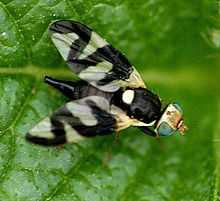Urophora cardui
| Urophora cardui | |
|---|---|
 | |
| Scientific classification | |
| Kingdom: | Animalia |
| Phylum: | Arthropoda |
| Class: | Insecta |
| Order: | Diptera |
| Family: | Tephritidae |
| Genus: | Urophora |
| Subgenus: | Urophora |
| Species: | U. cardui |
| Binomial name | |
| Urophora cardui (Linnaeus, 1758) | |
| Synonyms | |
| |
Urophora cardui or the Canada thistle gall fly is a fruit fly which, contrary to its common name, is indigenous to Central Europe from the United Kingdom east to near the Crimea, and from Sweden south to the Mediterranean.
Distribution
The Canada thistle gall fly has been introduced to North America from Europe to control the population of its host plant, Canada, or creeping thistle, which is an invasive, introduced weed in North America.

Life cycle
The fly starts life as an egg, about one to thirty of them, laid on the stems of its host plant, the Canada thistle, Cirsium arvense, during the host's growing season. After hatching, the larvae burrow into the stem of the plant and form a gall (or swelling). During maturing, the larva will be 98% of its full body weight, and appear as an adult. The larvae pupate in early spring for 24 to 35 days, and appear reddish brown, but are still inside the gall. The fly goes through a tunnel formed in the gall during June to October.